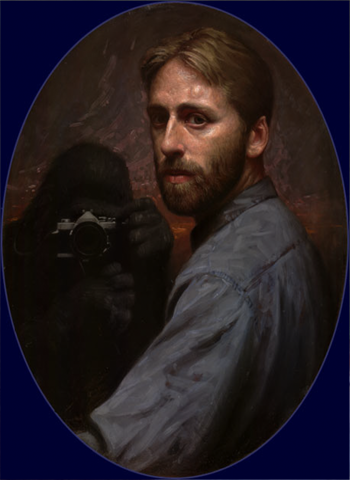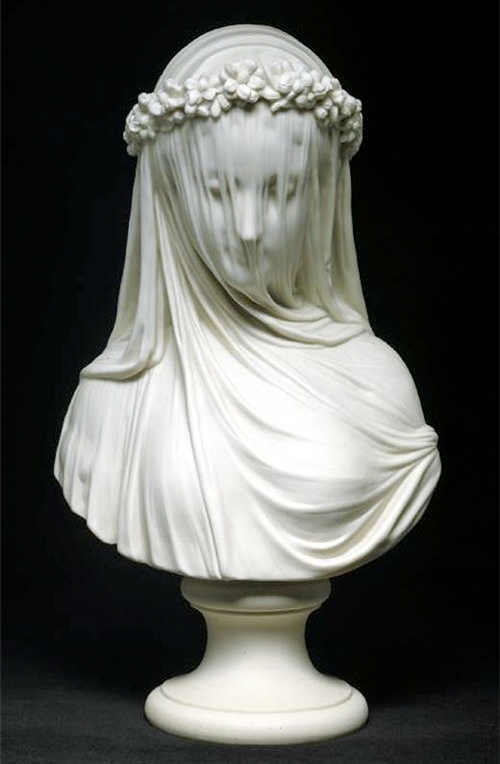The Postmodern era begins around the end of World War II, in 1945, and The Vietnam War: The Cold War, ‘55-’75. In the USA political and racial turmoil contribute to the reasons why Martin Luther King, President John F. Kennedy, and his brother Senator Robert F. Kennedy are assassinated. People learn to exchange naivety for harsh reality. Postmodern painting reflects trained artists’ responses. No longer dependent upon classical teachings, some artists begin to incorporate image-based commercial products and services. This collection of paintings illustrates the unleashing of artistic freedom.
Conor Walton (1970 -) Walton lives with his family in the hilly countryside of Wicklow, Ireland - a day’s drive from Dublin, his birthplace.
Of Monkey Painting (Self-portrait) he says, “There is always an element of role-play, in portraiture. When I paint myself, I usually assume the rather obvious role of painter. Monkey Painting is intended as an homage to seventeenth-century portraiture. Monkeys were often displayed in human clothes, performing human actions. They were generally symbolic of human foolishness and vanity.”
The moment I saw Veiled, I asked Conor for permission to include his painting on my website. Even though Veiled is Postmodern work, I see it as a fusion of Renaissance, Modern, and Postmodern eras. For that reason, I display it first on the Home Page scroll.
The highest degree of draftsmanship and mastery of classical Chiaroscuro (light and shadow) in still life painting and portraiture, is represented in a 21st century esthetic - how exciting!
Walton receives a B.A. (Joint Honours degree) in Art History and Fine Art from the National College of Art and Design in Dublin, in 1993. An M.A. in Art History and Theory from the University of Essex, UK (awarded with distinction) follows in 1995. Walton goes on to study painting and old-master techniques with Charles H. Cecil, in Florence, Italy.

Postmodern Era, Representational Art (from 1980 – present) Conor Walton dispels art critics’ concerns that beautiful, painterly images are all but forgotten in the Postmodern era.
Mr. Walton’s pairing of old-world charm and contemporary flair, with unexpected juxtapositions of objects, is exciting to viewers.
During the Italian Renaissance, sculptures of veiled figures peak in popularity giving artists the chance to demonstrate their ability to carve marble delicately.
Milanese sculptor, Raffaele Monti is known for marble busts draped in filmy veils.
Veiled Lady illustrates Monti’s subtle modeling to suggest feminine allure and mystery. As with paintings, so with sculpture, the desire to look through something to see more of it is irresistible.
Mr. Walton’s fusion of Monti’s mid-19th century young woman looking down on fresh fruit, in plastic bags, straight from a grocery is a mouth-watering, unexpected juxtaposition.

Go on to Describe, Analyze, Interpret & Conclude. Contact me for help.
Veiled (2012. Oil on linen. 18 x 20 in. (46 x 51 cm.) Open Walton’s website. Click Paintings under CONOR WALTON. Scroll down to Still Life 2. Click find out more about this painting. Scroll down below Conor’s notes. A copy of the Veiled Lady bust is displayed on the left next to Walton's easel.
Notice his process and how he arranges the elements of his composition.
If you do not have time to read Conor’s entire essay now, your docent excerpted these paragraphs.
“When painting a picture such as this, I usually place the canvas close to the objects to be depicted, my aim being to transcribe as faithfully as possible the dynamic of light and colour in the original.”
“In this pursuit, I push to utilize the entire tonal range from white to black and the entire chromatic range from neutral greys to the most intensely saturated colors, these extremes within the picture remain bound together and controlled by their inter-relationships; by the optical coherence of these relationships. The result, while strikingly forceful and vibrant, remains naturalistic and harmonious.”
Docent’s note: Perception of different colors is determined by the rods and cones in the retina. Rods are sensitive to light. Cones are sensitive to color.